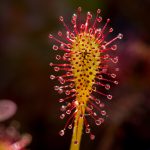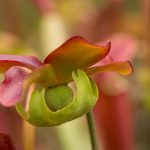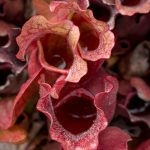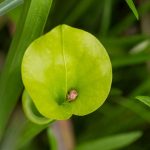The Savage Garden
Peter D’Amato, And Carnivorous (Even Murderous!) Plants
By: Cynthia Adams | Photos By: Nancy Evelyn
Peter D’Amato, a “savage gardener” and science writer for 40 years, says there are a fascinating number and variation of carnivorous plants here in the United States. They are often found in the Southeast, yet there are species found up into New England and reaching across into the Pacific Northwest. (According to Jessica Stephens, there are more than 650 different species to be found worldwide. The Southeast easily has 29 different species.)
Sadly, “Only five percent of our native carnivorous plant habitats remain in the Southeast,” D’Amato says. Once “an amazing belt of habitat for carnivores,” D’Amato writes that they are now on the verge of extinction.
Carnivorous plants are identified as flowering predators, which can capture and kill in order to feed. They not only have the ability to capture insects, spiders, crustaceans and more, but digest them. The majority of their nutritional needs (nitrogen and phosphorus) are gained from their prey as they are commonly found in nutrient poor soils.
Further, carnivorous plants are known to eat “small soil and water-living invertebrates and protozoans, lizards, mice, rats, and other small vertebrates,” according to a website devoted to
a 1,000-member society exclusively devoted to the study of carnivorous plants.
“Carnivorous plants pull off this trick using specialized leaves that act as traps. Many traps lure prey with bright colors, extra-floral nectaries, guide hairs, and/or leaf extensions. Once caught and killed, the prey is digested by the plant and/or partner organisms. The plant then absorbs the nutrients made available from the corpse. Most carnivorous plants will grow without consuming prey but they grow much faster and reproduce much better with nutrients derived from their prey.”
They add that also, there are many other types of plants with some features of carnivorous plants, but it is more difficult to argue they are true carnivores. “If these plants kill non-plants in an obvious, body present way, but do not derive significant nutrition from the victim, they are considered murderous plants.”
These species are truly oddities of nature that fascinate children and adults alike. In fact Charles Darwin once wrote in a letter “…at this present moment, I care more about Drosera than the origin of all the species in the world.” He also felt the Venus fly trap was “one of the most wonderful plants in the world.”
5 Basic Trapping Mechanisms found in Carnivorous Plants:
- Pitfall Traps (pitcher plants) trap prey in a rolled leaf that contains a pool of digestive enzymes or bacteria.
- Flypaper traps use a sticky mucilage.
- Snap traps utilize rapid leaf movements.
- Bladder traps suck in prey with a bladder that generates an internal vacuum
- Lobster-pots, also known as eel traps, force prey to move towards a digestive organ with inward-pointing hairs.
- Sarracenia leucophylla (white topped pitcher plant)
- Sundew Drosera
- Sarracenia flower
- Sarracenia purpurea
- Sarracenia flava













